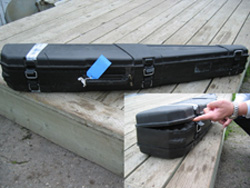
Well my inbox is filling up again with emails, as it did last month when I reported the following story for
The New York Times on pilot complacency and cockpit automation.
Prompting the latest flurry of comments is a June 15, 2010 article by Andy Pasztor and Daniel Michaels in the Wall Street Journal about the crash in May 2010 crash of an Afriqiyah Airways A330. Only one of the 104 people on the Airbus A330 from Johannesburg to Tripoli survived the accident.
According to Pasztor and Michaels the landing accident is being seen as one in “which confused pilots got out of sync with the plane's computerized controls and ended up flying an apparently functioning commercial jet into the ground.”
This is no one-off event. A number of studies over the past 15 years indicate pilots fail to adequately monitor what the airplane is doing in one-half to three-quarters of all accidents. So in the wake of the Afriqiyah Airways disaster, what’s the big idea being proposed? More automation. That’s right, Airbus is said to be working to “devise foolproof automated ground-collision avoidance systems” that in cases of emergency transfer control from the pilots to the airplane.
“This is very disturbing”, wrote Hugh Schoelzel, a retired captain who worked as director of safety for TWA. “The more automation we add, the more training and pilot qualification issues arise. I believe in automation, but as an adjunct to basic pilot skills, not as an ‘end-all’.”
While automation may be causing a decrease in piloting skills as Mr. Schoelzel suggests, Professor Missy Cummings of the Massachusetts Institute of Technology says there is another reason to be concerned about cockpit automation; boredom.
 Dr. Cummings a former Navy pilot, is director of the humans and automation laboratory at MIT’s department of Aeronautics and Astronautics. Not surprisingly she is a proponent of automation and envisions a future that will include at least some pilotless commercial flights. But first some extremely troublesome problems have to be wrestled to the ground, problems demonstrated by one of Dr. Cummings students, Master’s degree candidate First Lt. Christin S. Hart, who has found that too much automation can prove counter-productive.
Dr. Cummings a former Navy pilot, is director of the humans and automation laboratory at MIT’s department of Aeronautics and Astronautics. Not surprisingly she is a proponent of automation and envisions a future that will include at least some pilotless commercial flights. But first some extremely troublesome problems have to be wrestled to the ground, problems demonstrated by one of Dr. Cummings students, Master’s degree candidate First Lt. Christin S. Hart, who has found that too much automation can prove counter-productive.
“Increased automation can lower an operator’s workload too much, leading to mental underload, which can cause a decrement in vigilance, or sustained alertness, and lead to boredom. It has been shown that boredom produces negative effects on morale, performance, and quality of work,” she wrote in her paper, Assessing the Impact of Low Workload in Supervisory Control of Networked Unmanned Vehicles.
These findings do not surprise Dr. Cummings “The human mind craves stimulation”, she explained to me last week during a visit to her office in Cambridge. Failing to find that stimulation in the task at hand, the mind will wander.
This cuts to the heart of a number of events outlined by industry researchers but takes us at warp speed to the episode last October in which two Northwest Airlines pilots overflew their destination - the Minneapolis airport. The Northwest pilots were doing personal work on their laptops which is not allowed.
“It doesn’t have anything to do with automation,” FAA Administrator Randy Babbitt told me. “Any opportunity for distraction doesn’t have any business in the cockpit. Your focus should be on flying the airplane.”
But if I’m reading Lt. Hart’s study properly, the automation itself is an opportunity for distraction, even as it assists pilots by reducing workload and increasing the precision of calculations and navigation.
This is a conundrum. In today’s cockpit, two highly complex systems – the mind and the computer – come together, even though the contours of that intersection are still being mapped. It is not only unwise to race to a fix that fails appreciate these systems in balance, but it is unlikely to result in success.
Related Content
NTSB opens public docket on Northwest overflight

















